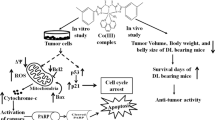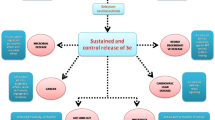Abstract
The present study was undertaken to explore the effect of administration of high doses of sodium selenite on the apoptosis of lymphoma cells in patients with non-Hodgkin’s lymphoma (NHL). Forty patients with newly diagnosed NHL were randomly divided into two groups. Group I received standard chemotherapy, whereas group II received adjuvant sodium selenite 0.2 mg kg−1 day−1 for 7 days in addition to chemotherapy. Flow cytometry was used for monitoring of lymphoma cells apoptosis at the time of diagnosis and after therapy in the two groups. Sodium selenite administration resulted in significant increase in percentage of apoptotic lymphoma cells after therapy in group II (78.9 ± 13.3% versus 58.9 ± 18.9%, p < 0.05). In addition, patients who received sodium selenite treatment demonstrated statistically significant increase in percentage of reduction of cervical and axillary lymphadenopathy, decrease in splenic size, and decreased percentage of bone marrow infiltration. Also, we found a statistically significant decrease in cardiac ejection fraction (CEF) in group I and no reduction in CEF in patients who received sodium selenite ‘group II’, denoting the cardioprotective effect of selenium. It is concluded that sodium selenite administration at the dosage and duration chosen has synergistic effect to chemotherapy in inducing apoptosis and, consequently, could improve clinical outcome.


Similar content being viewed by others
References
Allan CB, Lacourciere GM, Stadtman TC (1999) Responsiveness of selenoproteins to dietary selenium. Annu Rev Nutr 19:1–16
Thomson CD (2004) Assessment of requirements for selenium and adequacy of selenium status: a review. Eur J Clin Nutr 58:391–402
Clark LC, Cantor KP, Allaway WH (1991) Selenium in forage crops and cancer mortality in U.S. counties. Arch Environ Health 46:37–42
Schrauzer GN, White DA, Schneider CJ (1977) Cancer mortality correlation studies—III: statistical associations with dietary selenium intakes. Bioinorg Chem 7:23–31
El-Bayoumy K (2001) The protective role of selenium on genetic damage and on cancer. Mutat Res 475:123–139
Clark LC, Combs GF Jr, Turnbull BW et al (1996) Effects of selenium supplementation for cancer prevention in patients with carcinoma of the skin. A randomized controlled trial. Nutritional Prevention of Cancer Study Group. JAMA 276:1957–1963
Duffield-Lillico AJ, Dalkin BL, Reid ME et al (2003) Selenium supplementation, baseline plasma selenium status and incidence of prostate cancer: an analysis of the complete treatment period of the Nutritional Prevention of Cancer Trial. BJU Int 91:608–612
Last K, Maharaj L, Perry J et al (2003) Presentation serum selenium predicts for overall survival, dose delivery, and first treatment response in aggressive non-Hodgkin’s lymphoma. J Clin Oncol 21:2335–2341
Asfour IA, Fayek M, Raouf S, Soliman M, Hegab HM, El-Desoky H, Saleh R, Moussa MAR (2007) The impact of high-dose sodium selenite therapy on Bcl-2 expression in adult non-Hodgkin’s lymphoma patients: correlation with response and survival. Biol Trace Elem Res 120(1–3):1–10 (Dec)
Asfour IA, El Shazly S, Fayek MH, Hegab HM, Raouf S, Moussa MAR (2006) Effect of high-dose sodium selenite therapy on polymorphonuclear leukocyte apoptosis in non-Hodgkin’s lymphoma patients. Biol Trace Elem Res 110(1):19–32 (April)
Lu J, Kaeck M, Jiang C, Wilson AC, Thompson HJ (1994) Selenite induction of DNA strand breaks and apoptosis in mouse leukemic L1210 cells. Biochem Pharmacol 47:1531–1535
Kim T, Jung U, Cho DY, Chung AS (2001) Se-methylselenocys-teine induces apoptosis through caspase activation in HL-60 cells. Carcinogenesis 22:559–565
Cho DY, Jung U, Chung AS (1999) Induction of apoptosis by selenite and selenodiglutathione in HL-60 cells: correlation with cytotoxicity. Biochem Mol Biol Int 47:781–793
Shen HM, Yang CF, Ong CN (1999) Sodium selenite-induced oxidative stress and apoptosis in human hepatoma HepG2 cells. Int J Cancer 81:820–828
Jiang XR, Macey MG, Lin HX, Newland AC (1992) The antileukemic effects and the mechanism of sodium selenite. Leuk Res 16(4):347–352
Wilson AC, Thompson HJ, Schedin PJ, Gibson NW, Ganther HE (1992) Effect of methylated form of selenium on cell viability and the induction of DNA strand breakage. Biochem Pharmacol 43:1137–1141
Lockwood K, Moesgaard S, Hanioka T, Folkers K (1994) Apparent partial remission of breast cancer in high-risk patients supplemented with nutritional antioxidants. Mol Aspect Med 15(Supple):231–240
Asfour IA, El Koaly MN, Kachour KR, Fathy O (1996) Clinical utility of plasma selenium levels and glutathione peroxidase activity in the follow up of adult lymphoma patients, Egypt. J Hematol 21(Suppl.):477–497
Yu SY, Zhu YJ, Li WG, Huang QS, Huang CZ, Zhang QN, Hou C (1991) A preliminary report on the intervention trials of primary liver cancer in high-risk populations with nutritional supplementation of selenium in China. Biol Trace Elem Res 29(3):289–294 (Jun)
Emlen W, Nieber J, Kadera R (1994) Accelerated in vitro apoptosis of lymphocytes in patients with SLE. J Immunol 152:3658–3691
Jemal A, Tiwari RC, Murray T, Ghafoor A, Samuels A, Ward E, Thun MJ (2004) Cancer statistics. Cancer J Clin 54:8–29
Fisher SG, Fisher RI (2004) The epidemiology of non-Hodgkin’s lymphoma. Oncogene 23(38):6524–6534
Rayman MP (2005) Selenium in cancer prevention: a review of the evidence and mechanism of action. Proc Nutr Soc 64(4):527–542 (Nov)
Combs GF Jr, Gray WP (1998) Chemopreventive agents: selenium. Pharmacol Ther 79:179–192
El-Bayoumy K, DeVita V, Hellman S, Rosenberg SA (1991) The role of selenium in cancer prevention. In: DeVita VT, Hellman S, Rosenberg SA (eds) Cancer principles and practice of oncology. 4th edn. Lippincott, Philadelphia, pp 1–15
Stadtman TC (1996) Selenocysteine. Annu Rev Biochem 65:83–100
Sinha R, Said TK, Medina D (1996) Organic and inorganic selenium compounds inhibit mouse mammary cell growth in vitro by different cellular pathways. Cancer Lett 107:277–284
Lanfear J, Fleming J, Wu L, Webster G, Harrison PR (1994) The selenium metabolite selenodiglutathione induces p53 and apoptosis: Relevance to the chemopreventive effects of selenium? Carcinogenesis 15:1387–1392
Pines J (1994) The cell cycle kinases. Semin. Cancer Biol 5:305–313
Pines J (1995) Cyclins, CDKs and cancer. Semin Cancer Biol 6:63–72
Menter DG, Sabichi AL, Lippman SM (2000) Selenium effects on prostate cell growth. Cancer Epidemiol Biomarkers Prev 9:1171–1182
Zeng H (2002) Selenite and selenomethionine promote HL-60 cell cycle progression. J Nutr 132:674–679
Ip C, Thompson HJ, Ganther HE (2000) Selenium modulation of cell proliferation and cell cycle biomarkers in normal and premalignant cells of the rat mammary gland. Cancer Epidemiol Biomarkers Prev 9:49–54
Thompson CB (1995) Apoptosis in the pathogenesis and treatment of disease. Science 267:1456–1462
Cryns V, Yuan J (1998) Proteases to die for. Genes Dev 12:1551–1570
Gopalakrishna R, Chen ZH, Gundimeda U (1997) Selenocompounds induce a redox modulation of protein kinase C in the cell, compartmentally independent from cytosolic glutathione: Its role in inhibition of tumor promotion. Arch Biochem Biophys 348:37–48
Spyrou G, Bjornstedt M, Kumar S, Holmgren A (1995) AP-1 DNA-binding activity is inhibited by selenite and selenodiglutathione. FEBS Lett 368:59–63
Adams J (2002) Preclinical and clinical evaluation of proteasome inhibitor PS-341 for the treatment of cancer. Curr Opin Chem Biol 6:493–500
Aggarwal BB (2004) Nuclear factor-nB: the enemy within. Cancer Cell 6:203–208
Turco MC, Romano MF, Petrella A, Bisogni R, Tassone P, Venuta S (2004) NF-nB/Rel-mediated regulation of apoptosis in hematologic malignancies and normal hematopoietic progenitors. Leukemia 18:11–17
Nakanishi C, Toi M (2005) Nuclear factor-nB inhibitors as sensitizers to anticancer drugs. Nat Rev Cancer 5:297–309
Juliger S, Goenaga-Infante H, Lister TA, Fitzgibbon J, Joel PS (2007) Chemosensitization of B-cell lymphomas by methylseleninic acid involves nuclear factor-KB inhibition and the rapid generation of other selenium species. Cancer Res 67(22):10984–10992
Gopee VN, Johnson JV, Sharma PR (2004) Sodium selenite-induced apoptosis in murine B-lymphoma cells is associated with inhibition of protein kinase C-δ, nuclear factor-κB, and inhibitor of apoptosis protein toxicological. Science 78:204–214
Philchenkov A, Zavelevich M, Khranovskaya N, Surai P (2007) Comparative analysis of apoptosis induction by selenium compounds in human lymphoblastic leukemia MT-4 cells. Exp Oncol 29(4):257–261
Last K, Maharaj L, Perry J, Strauss S, Fitzgibbon J, Lister TA, Joel S (2006) The activity of methylated and non-methylated selenium species in lymphoma cell lines and primary tumours. Ann Oncol 17:773–779
Xiang N, Zhao R, and Zhong W (2008) Sodium selenite induces apoptosis by generation of superoxide via the mitochondrial-dependent pathway in human prostate cancer cells. Cancer Chemother Pharmacol. doi:10.1007/s00280-008-0745-3
Author information
Authors and Affiliations
Corresponding author
Rights and permissions
About this article
Cite this article
Asfour, I.A., El-Tehewi, M.M., Ahmed, M.H. et al. High-Dose Sodium Selenite Can Induce Apoptosis of Lymphoma Cells in Adult Patients with Non-Hodgkin’s Lymphoma. Biol Trace Elem Res 127, 200–210 (2009). https://doi.org/10.1007/s12011-008-8240-6
Received:
Accepted:
Published:
Issue Date:
DOI: https://doi.org/10.1007/s12011-008-8240-6




